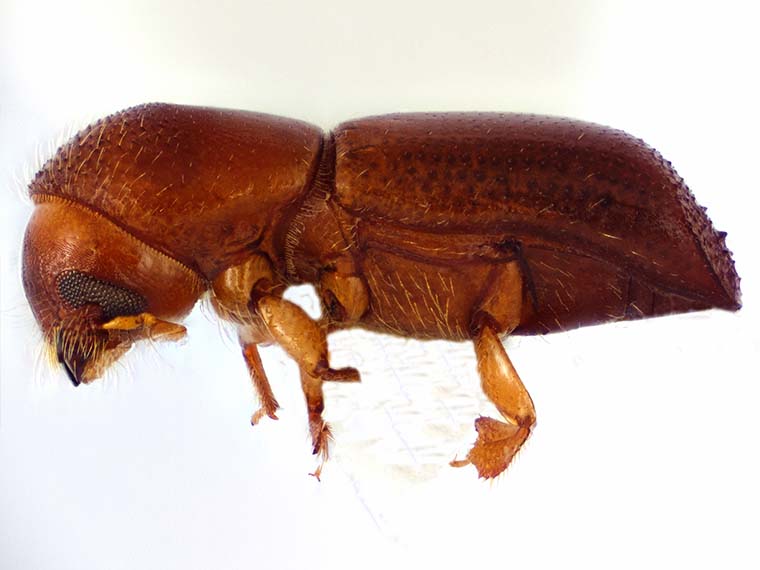Bye-bye Bay leaf
MAFES researchers study key invasive species in search of solutions
By: Alaina Dismukes
The information presented on this page may be dated. It may refer to situations which have changed or people who are no longer affiliated with the university. It is archived as part of Mississippi State University's history.
The redbay ambrosia beetle is believed to have been introduced from Asia to Port Wentworth, Georgia, in the early 2000s. They most likely came from infested, solid wood packing materials in a cargo container, which happens often with wood-boring insects. They then spread through infested materials-such as wood, ornamental plants, and debris-to Jackson County, Mississippi, where the beetles were discovered in 2009.
Previously, most ambrosia beetles were not known to cause damage to healthy trees, until the Laurel wilt epidemic. Laurel wilt can readily kill any plant in the family Lauraceae, which is more than a dozen species including redbay, swampbay, sassafras, avocado, pondspice, pondberry, northern spicebush, and more. If laurel wilt continues at its present pace, consumers can say goodbye to bay leaf, produced by the swampbay; guacamole, produced by avocado trees; and spicy gumbo, which contains sassafras.
MAFES scientist are now on the hunt for solutions to help determine the source of the infestation in Mississippi and quantify the ecological impacts of the beetle on U.S. forests. Dr. John Riggins, associate professor in the Department of Biochemistry, Molecular Biology, Entomology, and Plant Pathology, is the principle researcher on the project entitled, "Impacts of the redbay ambrosia beetle/laurel wilt disease on forests of the Southeast."
"As I began to work on the problem, I became fascinated with ambrosia beetles because they really are the perfect invader," Riggins said. "The beetle and the fungus it carries are capable of asexual clonal reproduction. That means, theoretically, one female beetle and the fungi she carried could have been the ultimate cause of a problem that has killed more than half a billion trees in the Southeast and threatens all the tree species in an entire plant family in North America."
The research project, which is examining occurrences of the beetle throughout the Southeastern U.S., began in 2009 and continues today as more data is collected.
"We have found that all of the samples of redbay ambrosia beetles and the fungus they carry that causes laurel wilt disease are genetically identical or clonal," said Riggins.
This indicates that they were introduced to the U.S. likely only once through the Georgia port near Savannah and spread from there, with help from humans, to Mississippi. Now, the disease can be found from North Carolina to Texas along coastal areas, and it is moving inland in sassafras trees, which presents a huge threat to the overall forested landscape. It is estimated that over a half a billion redbay trees, one species of tree in the plant family Lauraceae, have already been killed.
"All species of plants in the Lauraceae family in the Southeast are threatened by this problem," Riggins said. "There are many insects, birds, and other mammals that depend on these trees for food. We recently published a study where we reported that there are around two-dozen insects that are also in danger of mortality because of the loss of their host plant which is infected with laurel wilt. In total, there are over 175 native arthropod species that may be impacted on some level by the death of their host trees, caused by laurel wilt disease."
These impacts will continue to radiate out through ecosystems, as many birds and mammals rely on the small fruits, or drupes, grown by plants of this family.
Unfortunately, other research from Riggins' lab indicates that winters will not be cold enough to limit the beetles spread anywhere south of Canada, so it could, theoretically, find its way into southern Canada, killing sassafras and northern spicebush as it goes.
Riggins said that there are a few aspects that distinguish redbay ambrosia beetles from other invasive species.
"The fact that there is a symbiosis between two clonal organisms and that it threatens an entire plant family is one difference. Many other invasive forest insects or diseases have decimated one tree species, like chestnut blight and the American chestnut, or one tree genus, such as emerald ash borer and species of ash in the genus Fraxinus, but this invasion threatens the entire Lauraceae plant family," said Riggins.
While the research is still ongoing, one preventative measure Riggins's team has produced is a spatial model that helped to revise the predicted eventual range for the beetle's movement northward, which allows forest land managers to plan for this invasion to eventually effect northern forests.
Other individuals involved in the research are John Formby, a former doctoral student of Riggins who is now the forest health specialist for the state of New Mexico. Another student involved, Natalie Dearing, began working on this project while she was an undergraduate in the forestry program at MSU. After earning a bachelor's in forestry, she is now pursuing a doctoral degree under the direction of Riggins.
…theoretically, one female beetle and the fungi she carried could have been the ultimate cause of a problem that has killed more than half a billion trees in the Southeast and threatens all the tree species in an entire plant family in North America
Dr. John Riggins
Behind the Science

John Riggins
Associate Professor
Education: B.S., Comprehensive Biology, M.S., Biology, University of Nebraska, Kearney; Ph.D., Entomology; University of Arkansas
Years At MSU: 11
Focus: Basic and applied ecology of forest insects
Passion At Work: I’ve always been interested in “what makes things work,” which translates to asking questions about how forest insects respond to disturbances (like forest management practices, invasive species, or climate change), and how those responses shape forest ecosystems.

